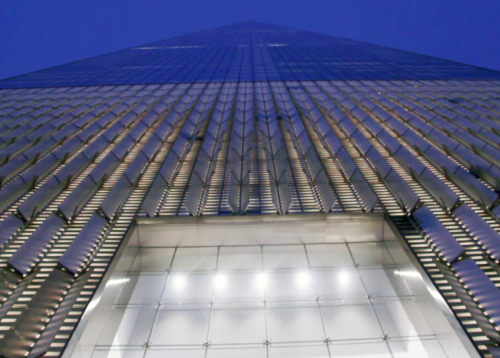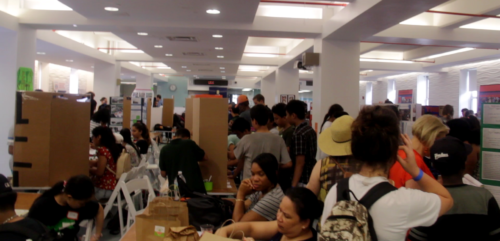Billion Oyster Conference and New York City Part 2: Shifting Baselines in America
Jamie Currie ·In late June, I accompanied Dr. Judy O’Neil into New York City for the Billion Oyster Project’s annual symposium. Before attending the conference, which I wrote about in another blog, I spent part of an afternoon exploring Manhattan. I spent most of my time wandering past the 9/11 memorials and new buildings. I ate cheap (but shockingly good) pizza, visited Wall Street, and even took the time to write a quick note to myself:

I’m standing at the foot of the One World Trade Center. A mighty spire of steel and glass, asymptotically curving towards a point just beyond my gaze. Standing in the right spot, I can almost make myself believe that it stretches onwards into the infinite blue.
The city hums with life: the high chatter of tourists, the tenor of an airplane, the basso roar of traffic. There’s something else as well; a deep rumble of rushing water, layering a sober drumroll beneath the breathing, pulsing echoes of New York. The sources of the rumble -- two deep reflecting pools -- flow behind me. Identical squares of dark stone, displaying the craters that mark the end of 20th century America. Their borders dusted with flowers, and thousands of names. Everyone has a different story: “I was in the grocery store, I was at school, I was driving in to work, I was on a train, I was asleep…”
Personally, I was a child when it happened. But I still vividly remember the flicker of the television screen, the images of clear morning sunshine, and the two dark grey towers falling from the sky.

Beneath the reflecting pools, the cavernous 9/11 Memorial Museum was filled with whispers. Images on the walls provided harsh reminders of the tragedy's scale and the simple courage shown by first responders and volunteers in the face of the unthinkable. However, the most breathtaking moment of all came as I was wandering past a group of students, and I overheard a young man asking one of his friends if she remembered 9/11. She said ‘no.’
That brought me up short. How on earth could they forget a day like that? But it’s a reality of life that eventually, you will remember events that others have only heard about. To them, your experiences, the historical events that you lived through, are an abstract concept. Their ‘normal’ world is very different from the world that older generations recognize – even if the difference is one short decade. These children were born into a time when more Americans are polarized on important issues than any time in living memory. A Pew poll in 2016 found that over 40% of republicans and democrats think each other's ideals are a ‘threat to the nation.’ A different poll found that only 65% of the American public believes climate change to be a threat, down from 77% in 2007 (Worldwatch Institute). And, increasingly, people are moving to areas where others share their political beliefs, leading to absolutist ideological differences among regions in the US. To the students I saw in the 9/11 museum, that is the only America they have ever known. That is the America they will expect to see when they grow up.

Have you ever heard of Shifting Baseline Syndrome? Possibly not, but if you’re an environmental scientist, or even have a passing interest in restoration ecology, odds are that you’ve encountered this idea. Shifting Baseline Syndrome, an idea originally coined by Daniel Pauly in 1995, is the idea that scientists use their own experiences – what they have seen and touched in their lives – to form expectations of what a ‘healthy environment’ should look like. However, few truly ‘healthy’ environments exist now, and because of this the remaining natural places identified as environmental ‘high water marks’ are significantly diminished from their original state.

Because people use damaged environments as a baseline, every successive generation has an incrementally lower expectation of what is ‘healthy.’ This syndrome is not restricted to scientists: many people today think the environment is as strong as it ever has been in their lifetimes. However, someone born 100 years earlier would likely disagree. Although the experiences of someone born in 1860 versus 1960 are separated by just one human lifetime, someone born in the mid 1800s grew up in a time when it was common to catch cod over three feet long (today, the average is less than a foot), when the floor of the Chesapeake Bay was covered with oysters, and when flocks of passenger pigeons over one billion strong migrated along the east coast. It is said that the sound they made passing overhead sounded like a fleet of steam locomotives, and that their vast flocks completely blotted out the sun. Today, there are none left. Shifting Baseline Syndrome is one of the reasons why children today know an increasingly urbanized world, complicated by invasive species, pollution, and global warming.

As I watched the sun go down over Manhattan, I thought about how the city was such an important example of how social and environmental baselines have shifted over the years. I had traveled to New York in order to attend a conference run by the Billion Oyster Project: an organization specifically designed to fight Shifting Baseline Syndrome. The project dedicates its resources to educating students about how New York Harbor has changed over time. When settlers first landed in New York Harbor, it boasted one of the most productive ecosystems on the planet, built on 350 square miles of oyster reefs. Within a few generations, those oyster reefs were completely destroyed. Today, no one even remembers a time when New York Harbor had healthy oyster populations. It was very strange to be wandering past the New York Stock Exchange, and to know that this urban jungle was once one of the richest ecosystems in the world. The Billion Oyster Project is helping to change New York's environmental baseline, both by educating children about what the harbor has lost, and by physically seeding the bottom with oysters to ensure that the harbor has a healthier and more sustainable future.

At the conference the next day, I was given a unique insight into Shifting Baseline Syndrome. I was helping to run a presentation of the IAN Symbol Library, showing young students how to use IAN symbols to represent scientific concepts. We were teaching a range of ages, from early grade school all the way through high school. The students had a simple task: use the symbol library to demonstrate the differences between a healthy New York Harbor and an unhealthy New York Harbor. I was impressed by the results: across the board, the unhealthy harbors showed the effects of increased runoff and pollution, while the healthy harbors boasted thriving commercial fisheries and a bottom covered in oysters. They also were inhabited by sandworms the size of highways and dolphins as large as skyscrapers.

While watching the students draw the difference between healthy and unhealthy versions of New York Harbor, I noticed something interesting. As the children created a healthy version of the harbor, they did not draw the harbor as it looks today. Instead they used their imaginations to look past how the harbor is, and to see it as it could be. This is something many adults find very difficult to do.

As I walked away from the conference, I thought about how difficult it is to recognize how one’s own baseline has shifted. It is hard to think of New York City as anything other than a vast metropolis. And yet these children appear to have been taught to imagine a cleaner, better version of the harbor with ease. It is essential that we teach ourselves to think like these students; to remember that we need to look past the world as it is today and see the potential of what it could be. We need to remind our children, and ourselves, that even though the world can be dark and grim, if we work hard to look past our own expectations we can create something stronger and more beautiful than what stood there before.


